Short Answer Questions - II - 3 Marks
Que 1. Suggest three contraceptive methods to control the size of human population which is essential for the health and prosperity of a country. State the basic principle involved in each.
Ans. The methods of contraception are:
(i) Barrier method or mechanical method (Condom/Diaphragm): Prevents the meeting of sperms and ova.
(ii) Chemical method (Oral pills): Changes the hormonal balance of the female partner so that the eggs are not released.
(iii) Surgical method: The vas deferens in males is blocked (vasectomy) or the fallopian tube (oviduct) in females (tubectomy) is blocked to prevent the transfer of sperms or egg and hence no fertilisation takes place.
(iv) IUCDs/ Loop or the copper-T is placed in the uterus to prevent pregnancy.
Que 2. List four points of significance of reproductive health in a society. Name any two areas related to reproductive health which have improved over the past 50 years in our country.
Ans. Significance of reproductive health in a society:
(a) It prevents the spread of various sexually transmitted diseases such as AIDS, syphilis, etc.
(b) Individuals with sound reproductive health produce better offspring which have better chances of survival.
(c) Better sex education and awareness helps to maintain the population and prevent population explosion.
(d) Unwanted and teen pregnancies can be avoided.
The reproductive health in India has improved tremendously over the past 50 years.
The areas in which reproductive health have improved are:
(a) Family planning (b) Mortality rate
Que 3. List four categories of contraceptive methods. State in brief two advantages of adopting such preventive methods.
Ans. The categories of contraceptive methods are:
(i) Barrier method (Condoms)
(ii) Surgical method
(iii) Withdrawal method
(iv) Calendar method
(v) Hormonal method
(vi) IUCD/Copper T/Loop
Two advantages of adopting preventive methods are:
(i) Helps in maintaining health of women.
(i) Helps in preventing STDs especially AIDS.
(iii) Helps in birth control.
(iv) Parents can give more attention to children.
Que 4. Name the reproductive parts of an angiosperm. Where are these parts located? Explain in brief the structure of its female reproductive parts.
Ans. (a) Each piece regenerates into a new Planaria.
(b) Its filaments break into smaller pieces or fragments and each fragment gives rise to a new filament.
(c) It releases spores which germinate into new mycelium in moist conditions.
Que 5. (a) Name the following:
(i) Thread like non-reproductive structures present in Rhizopus.
(ii) 'Blobs' that develop at the tips of the non-reproductive threads in Rhizopus.
(b) Explain how these structures protect themselves and what is the function of the structures released from the 'blobs' in Rhizopus.
Ans. (a) (i) Hyphae/mycelium, (ii) Sporangia
(b) These structures are protected by thick walls.
These structures germinate into new individuals under favourable conditions.
Que 6. Explain budding in Hydra with the help of labelled diagrams only
Ans.
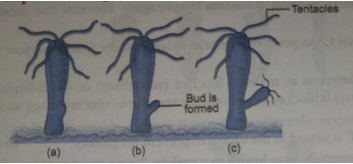
Que 7. Explain various steps of budding in yeast.
Ans. Yeast is a unicellular organism. Budding usually occurs when food is available in plenty. In budding, one or more outgrowths appear on one side, which enlarges in size. The nucleus divides mitotically, one daughter nucleus passes into the bud and the other remains in the parent cell. The bud either separates off from the parent cell or new bud appears before its separation from the parent cell resulting in the formation of branched or unbranched chain of buds.

Que 8. Explain the process of regeneration in Planaria. How is this process different from reproduction?
Ans. When Planaria is cut into many pieces, each piece grows into a complete organism. This regeneration process is carried out by specialised cells, which proliferate, develop and differentiate into various cell types and tissues.
Regeneration is not same as reproduction as most of the organisms would not normally depend on being cut up to be able to reproduce.
Que 9. Illustrate the following with the help of suitable diagrams:
(i) Spore formation in Rhizopus
(ii) Multiple fission in Plasmodium.
Ans. (i) Spore formation in Rhizopus: This is an asexual method of reproduction in bacteria and fungi. Spores are unicellular bodies formed by cell division in a parent organism. After detaching from the parent, and if conditions are suitable, they germinate directly or indirectly into a new individual.
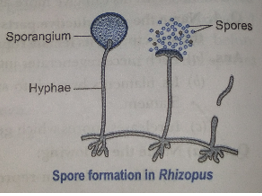
(ii) Multiple fission in Plasmodium: It is an asexual mode of reproduction in organisms. Here, the nucleus of the organism divides repeatedly to form a number of equal sized daughter nuclei and each daughter nuclei breaks away together with a small portion of the cytoplasm.
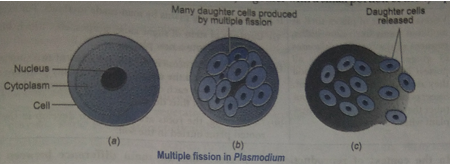
Que 10. (a) List two reasons for the appearance of variations among the progeny formed by sexual reproduction.
(b) (i) Name the part marked 'A' in the diagram alongside.
(ii) How does ‘A' reaches part 'B'?
(iii) State the importance of the part 'C'.
(iv) What happens to the part marked 'D' after fertilisation is over?
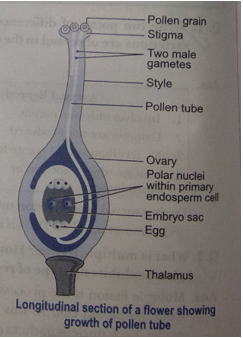
Ans. (a) Variation is seen among progeny formed by sexual reproduction because of:
(i) Involvement of two different individuals.
(ii) Creation of new combination of variants.
(b) (i) A-pollen or pollen grain.
(ii) It reaches the stigma (B) by agents of pollination.
(iii) C (pollen tube) helps male gamete to reach the egg (ovule).
(iv) After fertilisation it converts into embryo.
Que 11. How does natural vegetative propagation occur?
Ans. Natural vegetative propagation occurs from modified stems, roots, leaves and bulbs. Modified short stems, onion bear bulbs which when grown in soil develop into a new plant. Runners -stems of doob grass have nodes and internodes. From nodes, roots are developed that formed a new plant. Rhizome of ginger is a horizontal underground stem. If kept in soil with adequate moisture it develops into a new plant. Tuber of potato bears eyes (buds), which if sown (entire or in pieces) in soil develops into a new plant.
Modified root tubers of sweet potato also grow into a new plant.
Buds produced in the notches along the leaf margin of Bryophyllum fall on the soil and develop into new plants.
Que 12. Illustrate the following with help of suitable diagram:
Leaf of Bryophyllum with buds.
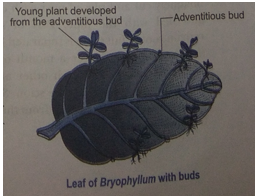
Ans. Leaf of Bryophyllum shows vegetative propagation in plants where a part of the body becomes detached and develops into a new supporting plant. Here, leaves of Bryophyllum pinnatum having plantlets along the leaf margins when grown in soil develops into a new plant.
Que 13. Differentiate between natural and artificial vegetative propagation in plants.
Ans.
|
Artificial Propagation |
Natural Propagation |
|
Vegetative parts of plants such as modified stems like onion bulbs, runners of doob grass, rhizomes of ginger, tuber of potato all possess buds. When sown in soil they develop into a new plant. Sweet potato (shakarkandi) is a root tuber that also develops into a new plant when sown in soil. |
It includes growing plants by man-made methods. For example, over each other and tied by a tape and left for a month or so. A new plant thus develops. |
Que 14. In the context of reproduction of species state the main difference between fission and fragmentation. Also give one example of each.
Ans. Fission is the method of asexual reproduction in unicellular forms of life. In this process the parent organism splits to form two or more daughter cells. Example, Ameoba and Plasmodiunm
Fragmentation is the process found in multicellular organisms. The filament breaks up into two or more pieces upon maturation. These pieces then grow into new individuals. Example, Spirogyna.
Que .15. What are the various methods of vegetative propagation? Discuss any one method with example.
Ans. The various methods of vegetative propagation are:
(i) cutting, (ii) layering,
(iii) grafting, (iv) tissue culture.
Layering: In layering, roots are induced on the stem of a rooted plant. When roots develop, that part of stem is detached from the parent plant and grown in the soil. Layering is of two types:
(i) Mound layering: A lower branch of a rooted plant is bent and buried into the moist soil. The tip of the branch should remain above the ground. In a few days, the buried part of the brand develops roots. It is now cut off from the parent plant and grown in the soil as a new plant.
This method is used in the propagation of grapevine, strawberry, raspberry, jasmine etc.
(ii) Air layering: This method is used in plants like crotons whose branches cannot be bent and buried in the soil. The stem is girdled, i.e., a ring of bark is removed and then it is covered with a moist moss or cotton and enclosed in a polythene bag. After a few days, roots emerge from this region and branch is cut off from the parent plant. It can now be planted in the soil as a new plant. This method is used in rose, rubber plant, guavas, pear, apple, mangoes, etc.
Que 16. State the process of grafting.

Ans. In grafting, stem parts of two different plants are joined to produce a new plant. One part is of in situ rooted plant called stock and another part from superior
quality plant called scion. Both are obliquely cut and placed over each other
and tied with the tape. Part of stock remains rooted but scion is separated from the
mother plant. After a month or so, both parts unite with each other and a new plant develops from the scion. Stock provides water and minerals from to the developing plant.
Que 17. Explain the term 'Regeneration' as used in relation to reproduction of organisms. Describe briefly how regeneration is carried out in multicellular organisms like Hydra.
Ans. Regeneration is the ability of an organism to give rise to a new organism or individual from their body parts.
Each part of Hydra contains specialised cells which have the ability to proliferate.
When the body of Hydra by any means is cut into number of pieces, these pieces proliferate and make large number of cells. From this mass of cells different cells undergo changes to become various cell types and tissues finally developing into a new organism.
Que 18. Explain four advantages of vegetative propagation.
Ans. (i) New plants produced by vegetative propagation maintain the desirable characters of the parents. These plants are genetically identical.
(ii) Certain plants like banana, grapes, pineapple, roses, jasmine, etc., do not form seeds. Thus, this is the only method of reproduction and continuation of such species.
(iii) This method is cheap and can be easily employed to reproduce plants, especially fruit plants.
(iv) Only one parent is required for reproduction.
Que 19. Describe double fertilisation in plants.
Ans. Soon after pollination the pollen grains start germinating and form a pollen tube. The pollen tube grows within the style till it reaches the ovary.
On reaching the ovary it enters the ovule through an opening called micropyle. In the meantime, two male gametes are formed in the pollen tube. One of the male gametes fuses with the egg, the process is called syngamy. The product formed is termed as zygote. The other male gamete fuses with the two polar nuclei, one from each end of embryo sac, to form endosperm nucleus. This process is called triple fusion. In this process three nuclei, two polar nuclei and one male gamete is involved, so it is called triple fusion. Thus, inside each embryo sac two fusions, i.e., syngamy and triple fusion take place. This mechanism of two fusions occurring in an embryonal sac is called double fertilisation. After fertilisation, the ovule develops into seed and the ovary develops into a fruit.
Que 20. What is sexual reproduction? List its two significances.
Ans. Two major processes namely formation of gametes and fusion of gametes constitute sexual reproduction.
Its significances are:
(i) Incorporates the process of combining DNA from two different individuals during reproduction.
(ii) Increases genetic variation.
(iii) Promotes diversity in the offsprings.
(iv) Plays a role in the origin of new species.
Que 21. Mention secondary sexual characters in human male and female.
Ans. Secondary sexual characters
Male:
1. Hair growth on face, chest, armpit (axillae) and over pubis.
2. Voice becomes deep and hoarse due to growth of larynx called Adam's apple.
3. Body becomes muscular.
Female:
1. Growth of breasts and hair in axillae and over pubis
2. Pelvis region becomes broad and buttocks become heavy due to deposition of fat.
3. Development of accessory sex organs.
Que 22. (a) Mention the role of the following organs of human male reproductive system:
(i) Testis; (ii) Scrotum; (iii) Vas deferens; (iv) Prostate glands.
(b) What are the two roles of testosterone?
Ans. (i) Testis: to produce male gametes.
(ii) Scrotum: to provide optimal temperature to testis for the formation of sperms.
(iii) Vas deferens: to deliver the sperms to the urinary bladder.
(iv) Prostrate glands: to secrete the fluid which provides nutrition and medium for transport of sperms.
(b) Testosterone has following roles:
(i) regulates formation of sperms.
(ii) brings about the changes in boys during adolescence.
Que 23. Explain how, offspring and parents of organisms reproducing sexually have the same number of chromosomes.
Or
How do organisms, whether reproduced asexually or sexually maintain a constant chromosome number through several generations? Explain with the help of suitable example.
Ans. During asexual reproduction organisms undergo only mitotic divisions. The DNA (in the chromosomes) of the cells involved are copied and then equally divided among the two daughter cells formed. Thus, chromosome number remains unchanged.
In sexual reproduction, organisms produce gametes through meiosis, which is called reductional division, in which the original number of chromosomes becomes half. These two gametes combine to form the zygote and the original number of chromosomes is restored.
For example, in humans, the parents (father and mother) each have 46 or 23 pairs of chromosomes. In the gametes, the sperm has half the number of chromosomes, i.e., 23 and the egg also has 23 chromosomes. When the sperm and the egg fuse, the zygote has 46 or 23 pairs of chromosome. Thus, the chromosome number remains constant.
Que 24. What are the male and female gonads in human beings? Mention their functions.
Ans. The male gonads in human beings are a pair of testes. The testis lies in a sac outside the abodominal cavity called scrotum. The function of testis is to regulate the production of sperms and secretion of male hormone, testosterone. The female gonads in human beings are pair of ovaries located in the abdominal cavity near the kidneys. The ovaries perform dual functions of:
(i) production of female hormones oestrogen and progesterone.
(ii) production of female gamete ovum/ova.
Que 25. From the internet, gather information about the chromosome numbers of five animals and five plants. Correlate the number with the size of organism and answer the following questions.
(a) Do larger organisms have more number of chromosomes/cells?
(b) Can organism with fewer chromosomes reproduce more easily than organisms with more number of chromosomes?
(c) More the number of chromosomes/cells greater is the DNA content. Justify.
Ans. (a) No, there is no relationship between size of organism and its chromosome number.
(b) No, process of reproduction follows a common pattern and is not dependent on the number of chromosomes.
(c) Yes, since the major component of chromosome is DNA, if there are more chromosome in a cell, the quantity of DNA will also be more.
Que 26. What happens when
(a) Planaria gets cut into two pieces?
(b) A mature Spirogyra filament attains considerable length?
(c) On maturation sporangia burst?
Ans. (a) Each piece regenerates into a new Planaria.
(b) Its filaments break into smaller pieces or fragments and each fragment gives rise to a new filament.
(c) It releases spores which germinate into new mycelium in moist conditions.
Que 27. Mention the information source for making proteins in the cell. What is the basic event in reproduction?
Ans. The DNA in the nucleus of a cell is the information source for making proteins. If the information is changed, different proteins will be made. The basic event in reproduction is the creation of a DNA copy. Cells use chemical reactions to build copies of their DNA. This creates two copies of the DNA in a reproducing cell and they need to get separated from each other. DNA copying is accompanied by the creation of an additional cellular apparatus, and then the DNA copies separate, each with its own cellular apparatus.
Que 28. (a) Write the names of those parts of a flower which serve the same function as the following do in the animals.
(i) testis, (ii) sperm
(iii) ovary, (iv) egg
(b) State the function of flowers in the flowering plants.
Ans. (a) (i) testis anther (ii) sperm pollen grains
(iii) ovary ovary (iv) egg ovum
(b) Flowers are responsible for sexual reproduction as they contain the reproductive organs of the plant.
Que 29. Name the parts A, B and C shown in the following diagram and state one function of each.
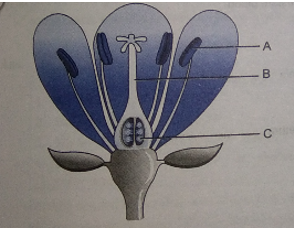
Ans.
|
|
Part |
Function |
|
A
|
Anther
|
It produced pollen grains. |
Que 30. What are sexually transmitted diseases? List two examples of each disease caused due to (i) bacterial infection and (ii) viral infection. Which device or devices may be used to prevent the spread of such diseases?
Ans. Diseases which are transmitted from an infected person to a healthy person due to unsafe sex are called sexually transmitted diseases.
Two examples:
Bacterial disease: Gonorrhoea and syphilis
Viral disease: Warts and AIDS
Preventive measures: Use of condoms or similar coverings.
Que 31. (i) Name any two sexually transmitted diseases (STDs). How do these infectious diseases spread from one person to another? Give two symptoms of STDs.
(ii) Explain why fertilisation is possible if copulation takes place during the middle of menstrual cycle.
Ans. (i) The two sexually transmitted diseases (STDs) are gonorrhoea and syphilis. These infectious diseases spread from one person to another by sexual contact with an infected person. Two symptoms of STDs are burning sensation at urination and urethral discharge and sores in the genitals.
(ii) Since ovulation, i.e., the release of ovum occurs on the 14th day of the menstrual cycle, i.e., in its middle, chances are more for the sperms to fertilise the egg or ovum during this time.
Que 32. Write the full form of IUCD, AIDS, HIV, OC.
Ans. IUCD = Intra-Uterine Contraceptive Device
HIV = Human Immunodeficiency Virus
AIDS = Acquired Immune Deficiency Syndrome
OC = Oral Contraceptive
Que 33. Draw a labelled diagram of a human male reproductive system.
Ans.
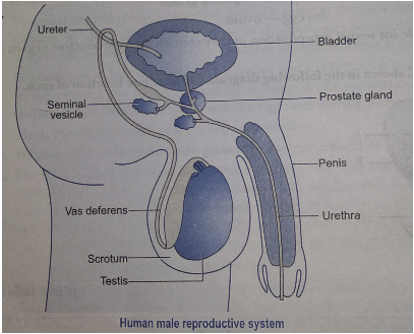
Que 34. What is placenta? Mention its role during pregnancy.
OR
What is placenta? Explain its function in humans.
Ans. Placenta is a special tissue connection between embryo and uterine wall. It acts as an endocrine gland.
Role of placenta:
(i) It possesses villi that increase the surface area for absorption of nutrients.
(ii) Facilitates passage of nutrition and oxygen to embryo from mother through blood.
(iii) Waste substances produced by embryo are removed through placenta into mother's blood.
Que 35. Draw a labelled diagram of a human female reproductive system.
Ans.
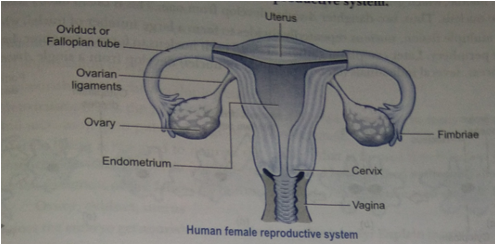
Que 36. What are the functions of testis in the human male reproductive system? Why are these located outside the abdominal cavity? Who is responsible for bringing about changes in appearance seen in boys at the time of puberty?
Ans. Functions of testis:
(i) Produce sperms. (ii) Produces male hormone/testosterone.
These are located outside the human body, as sperms need lower temperature than the normal body temperature to mature.
Testosterone is responsible for bringing changes at the time of puberty in boys.

